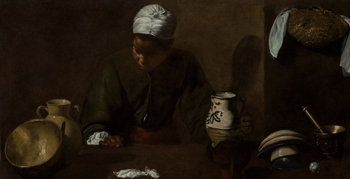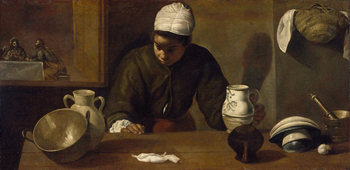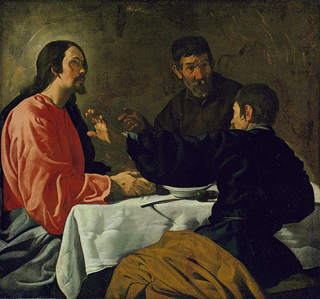The Kitchen Maid of Emmaus:
Three Paintings and a Poem
For Sunday May 4, 2014
Lectionary Readings (Revised Common Lectionary, Year A)
Acts 2:14a, 36–41
Psalm 116:1–4, 12–19
1 Peter 1:17–23
Luke 24:13–35
We don't really know that there was a maid in the kitchen at Emmaus. Luke doesn't mention her in his post-resurrection dinner story. But it's the genius of artistic imagination to express an unspoken truth.
Thanks to two paintings by Diego Rodríguez de Silva y Velázquez (1599–1660), and a poem about his paintings by Denise Levertov (1923–1997), we can relive the numinous shock of an ordinary person when she realized that the rumors of resurrection were true.
By the time that Cleopas and his unnamed companion had walked with Jesus the seven miles from Jerusalem to Emmaus, the evening darkness had descended upon them. When Jesus acted as if he would continue walking, they implored him, "stay with us, for the day is almost over." And so their dinner at Emmaus.
 |
The Kitchen Maid by Velázquez, the Art Institute of Chicago. |
During the day the men hadn't recognized Jesus, but at dinner "their eyes were opened" and they understood what had happened. They immediately returned to Jerusalem and told "how Jesus was recognized by them when he broke the bread. It is true! The Lord has risen!"
Unless we entertain the preposterous notion that the men cooked their own meal and served themselves, there had to be a woman behind the scenes. But Luke leaves her unnamed and unmentioned. And herein is the genius of Velázquez and Levertov — their artistic fictions imagine a historical reality.
Velázquez painted two versions of the "Kitchen Maid" (in Spanish, La mulata, La cocinera, or Escena de cocina). It's the earliest known work by him, painted when he was about eighteen.
The copy in the Art Institute of Chicago shows only the mullato maid. And for many decades the version in the National Gallery of Ireland in Dublin also showed only the servant girl. But when the Dublin painting was cleaned in 1933, it revealed Jesus and the two men in the distant background of the upper left corner. Clearly, the Dublin version was the dinner at Emmaus.
The main figure and visual center point in both paintings is the kitchen maid in the foreground. Jesus and the men are relegated to a back room in the background. We see them only through a window-like opening. Velázquez depicts the maid as a mullato, the offspring of a Spanish Christian and an African Muslim.
 |
The Kitchen Maid by Velázquez, the National Gallery of Ireland. |
Barry Wind comments that the Hispanic antipathy of that day toward Moors considered them "lazy, lubricious, and figuratively subhuman.” The subject of this painting, then, is a person marginalized at every level — by her race, religion, gender, and class. While the men speak of spiritual matters in the back, she's hard at work in the kitchen.
The woman is badly distracted. In her left hand she holds a ceramic jug of wine. She's glancing over her right shoulder, listening carefully to the back room conversation. She bends over to support herself. The stunned expression on her face indicates that her eavesdropping has confirmed her suspicion. She's in a state of shock at having recognized the man she's serving.
Whereas the men had been blind to the identity of Jesus even when he was with them for a seven-mile walk, the Moorish maid recognized the risen Christ while working in the mundane context of a kitchen. "God is found in the pots," said Teresa of Avila.
Denise Levertov's poem The Servant-Girl at Emmaus (A Painting by Velázquez) reimagines this moment. We know from a note of hers that she had seen the painting in Ireland. It's what's called an exphrasis — a literary description that illuminates a visual work of art. Levertov's poem is a meditation on Velázquez's painting.
She listens, listens, holding
her breath. Surely that voice
is his - the one who had looked at her, once, across the crowd,
as no one ever had looked?
Had seen her? Had spoken as if to her?
Surely those hands were his,
taking the platter of bread from hers just now?
Hands he'd laid on the dying and made them well?
Surely that face — ?
The man they'd crucified for sedition and blasphemy.
The man whose body disappeared from its tomb.
The man it was rumored now some women had seen this morning, alive?
Those who had brought this stranger home to their table
don't recognize yet with whom they sit.
But she in the kitchen, absently touching the wine jug she's to take in,
a young Black servant intently listening,
swings round and sees
the light around him
and is sure.
Like Velázquez's painting, Levertov's poem focuses not on Jesus or his companions but on the maid. She's having an interior conversation with herself.
As she listens to the men in the back room, she realizes that she's encountered Jesus before. At first it's his voice, then his gaze, his healing hands that now took the bread from her, and finally his face. The repetition of "surely" three times indicates her shocking realization that this is Jesus risen from the dead.
 |
The Supper at Emmaus by Velázquez, the Metropolitan Museum of Art in New York. |
Luke's story is often read as a eucharistic text, and for good reason. Luke 24:30 says that Jesus "took bread, gave thanks, broke it, and began to give it to them." These words are identical to all three accounts of the Last Supper in the synoptic gospels. It was precisely when Jesus "broke the bread" that "their eyes were opened" (24:31), a detail that Luke repeats a second time: "Then the two told [the other disciples] what had happened on the way, and how Jesus was recognized by him when he broke the bread" (24:35 ).
There's also a third painting by Velázquez, "The Supper at Emmaus," now in the Metropolitan Museum of Art in New York. It's very conventional. It depicts only Jesus, Cleopas, and his companion, at the eucharistic moment when they recognize the risen Lord in the breaking of the bread.
I prefer the Dublin and Chicago versions, and Levertov's poem about them. In them, the maid serves the bread, she doesn't take the bread. She's an observer and not a participant of the eucharist, a mullato outsider rather than a Spanish insider.
But it was the men who didn't believe the resurrection report of the women, and who were blind to the Christ who was right in front of them, whereas it was an African Muslim kitchen maid who testified first to the resurrected Lord.
Note: The reference to Barry Wind is in "Denise Levertov’s Religious Ekphrasis" by Cristina Giorcelli of the University of Rome. See here: http://www.pdfio.com/k-1578881.html
Image credits: (1) Wikipedia.org; (2) The National Gallery of Ireland; and (3) The Metropolitan Museum of Art, New York





